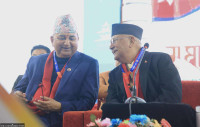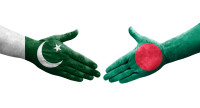Opinion
Miles to go
While more funds are necessary for reconstruction, utilisation of resources looks to be a greater challenge
Som P. Pudasaini
In the aftermath of the April 25 earthquake and the destruction it entailed, the government has completed the Post-Disaster Need Assessment (PDNA) and decided to establish a National Reconstruction Authority to help expedite reconstruction. To collect much-needed funds, the government also held the International Conference on Nepal’s Reconstruction (ICNR) on June 25. In light of Nepal’s weak implementation and absorptive capacity, it remains to be seen how the country can effectively manage post-quake rebuilding. Some political leaders and intellectuals are questioning whether the government currently is focusing on reconstruction (punarnirman) or new construction (nawanirman) too.
Money comes in
Nonetheless, the donors’ conference was a success on many counts. First, the participation of almost 300 representatives from 56 countries and several important donor agencies was impressive. This included foreign ministers from India, China and Norway and Japan. Also, the Asian Development Bank president along with the Japan International Cooperation Agency president and the World Bank vice-president for South Asia were in attendance. The US Secretary of State John Kerry and the UN Secretary General Ban Ki-Moon also thought it important enough to send video messages.
Further, the conference was organised in Kathmandu in spite of the desire of bilateral and multilateral international players to organise it elsewhere. This has boosted the confidence of the government to organise such international events in such a short period of time. Many common folks on the street seem also seem to have felt proud of its success. It was a positive development in politically uncertain times. Political party leaders across various parties and factions also seem to have developed a sense of unity with regards to mobilising financial resources for post-quake reconstruction.
Second, the participants pledged $ 4.4 billion at the Reconstruction Conference, exceeding the expectation of the government as well as that of critical observers. With the effective utilisation of the pledged amount and additional mobilisation of internal resources, Nepal should be able to move ahead with reconstruction—the PDNA assessed total losses to be $7 billion and the rebuilding cost to be $ 6.7 billion.
Accountability and the Authority
However, true success of the Reconstruction Conference hinges on effective reconstruction that is yet to start and there are a host of challenges that could come in its way.
First, the amount pledged by donors is only an expression of their desire to help Nepal. In order to get the pledged amounts, the government will have to prepare projects for its use and come to an agreement with the donors. The rules and conditionality of donors, which was not clear at the time of pledging, could, at times, make the release of the funds quite taxing. Also, red tapism on part of the government may affect the process of reaching agreements.
Second, widespread corruption, inadequate transparency and poor accountability are huge problems confronting Nepal which were also raised during the pledging. The prime minister was smart to commit zero tolerance for corruption and full transparency and accountability in his inaugural address to preempt donors’ concerns to an extent. Now, the government, political leaders and bureaucracy must be ready and capable to fulfill the promise for sustained credibility.
Third, it is crucial that the autonomous Reconstruction Authority be established promptly and be manned by a competent head and brought into operation immediately. On June 21, the government decided to establish an 11-member National Reconstruction Authority under the chairmanship of prime minister with a Chief Executive Officer (CEO) as its operational head. Four ministers, vice-chairman of the National Planning Commission (NPC), chief secretary and three experts will be ex-officio members. The Authority’s tenure will be five years. A 100-member Consultative Committee chaired by the prime minister; with all ministers, leaders of all parties represented in CA and former VCs of NPC would provide guidance and support to the Authority.
Still, the Authority does not seem to be quite up to the task. It should have been like a pyramid, broad and solid at the bottom and slim and smart at the top. The Authority ought to have a strong presence in villages and towns to assess the needs of the people through their participation and to deliver results promptly and transparently. This demands elected village and town development committees. Its function at the center should consist of policy formulation, resource mobilisation, coordination and monitoring. The CEO must be a professional candidate who should not be replaced with the change in the PM or on flimsy grounds of non-performance to benefit from the person’s learning curve. Regional units must be strengthened for storage, logistics and facilitation. The regional administrators’ offices and functions could be strengthened for this purpose. The District Disaster Management Committees must be upgraded to link better with central and regional set ups and to deliver and support town and village units.
Old and new
Fourth, the ongoing debate on whether reconstruction (punarnirman) or new construction (nawanirman) should be in the offing is hardly relevant. Construction, deconstruction and reconstruction are a continuous process. Nothing is permanent. New buildings and infrastructures become old. They collapse with age or due to natural disasters. Some damaged structures that are necessary and amenable to repair are reconstructed while new ones must be built to meet the need of changing times. Obviously, deconstruction or demolition, reconstruction and new construction will have to take place simultaneously. It is quite clear that any reconstruction and new construction must be done in such a way that we can protect our houses, infrastructure and livelihood better in the future, should we be faced with a similar or worse disaster.
Also, while more funds are necessary for reconstruction, utilisation of the resources looks to be a greater challenge. Finance Minister Ram Sharan Mahat has admitted that “most of the ministries had not even spent half of their budget” and “governance capacity” poses a serious challenge to the “reconstruction and rebuilding efforts”. Consequently, the government must focus on streamlining implementation. A concrete and clear plan must be developed for new construction and reconstruction. Additional internal resources can and must be mobilised and utilised. Further, the Constituent Assembly must complete the constitution promptly and hold the elections to local bodies. Then, the enhanced national desire for a better life that has developed in the post-quake Nepal can be captured for both punarnirman and navanirman.
Pudasaini is a former UNFPA Representative in Sri Lanka and Yemen and former Country Director for the Maldives ([email protected])




 10.12°C Kathmandu
10.12°C Kathmandu










